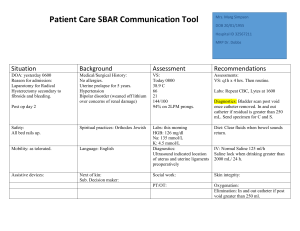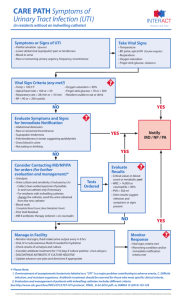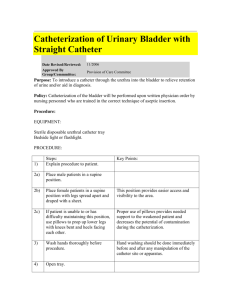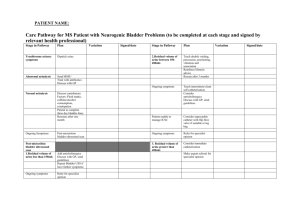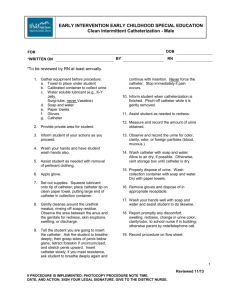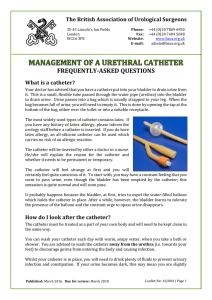Document 12497370
advertisement
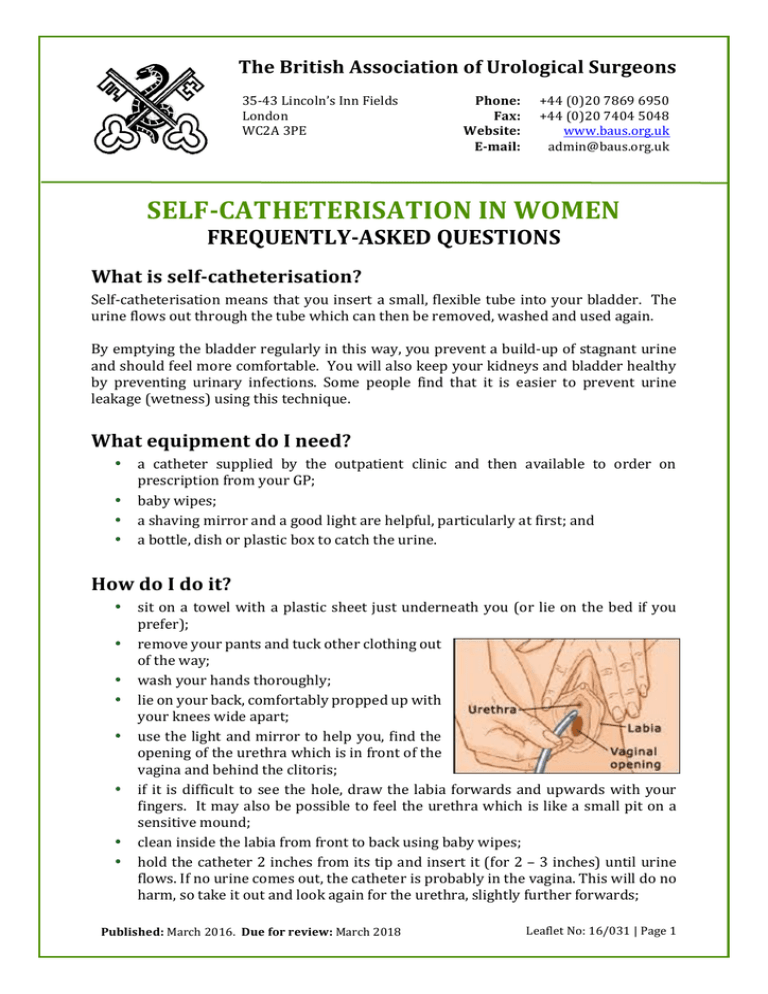
The British Association of Urological Surgeons 35-­‐‑43 Lincoln’s Inn Fields London WC2A 3PE Phone: Fax: Website: E-­‐‑mail: +44 (0)20 7869 6950 +44 (0)20 7404 5048 www.baus.org.uk admin@baus.org.uk SELF-­‐‑CATHETERISATION IN WOMEN FREQUENTLY-­‐‑ASKED QUESTIONS What is self-­‐‑catheterisation? Self-­‐‑catheterisation means that you insert a small, flexible tube into your bladder. The urine flows out through the tube which can then be removed, washed and used again. By emptying the bladder regularly in this way, you prevent a build-­‐‑up of stagnant urine and should feel more comfortable. You will also keep your kidneys and bladder healthy by preventing urinary infections. Some people find that it is easier to prevent urine leakage (wetness) using this technique. What equipment do I need? • • • • a catheter supplied by the outpatient clinic and then available to order on prescription from your GP; baby wipes; a shaving mirror and a good light are helpful, particularly at first; and a bottle, dish or plastic box to catch the urine. How do I do it? • • • • • • • • sit on a towel with a plastic sheet just underneath you (or lie on the bed if you prefer); remove your pants and tuck other clothing out of the way; wash your hands thoroughly; lie on your back, comfortably propped up with your knees wide apart; use the light and mirror to help you, find the opening of the urethra which is in front of the vagina and behind the clitoris; if it is difficult to see the hole, draw the labia forwards and upwards with your fingers. It may also be possible to feel the urethra which is like a small pit on a sensitive mound; clean inside the labia from front to back using baby wipes; hold the catheter 2 inches from its tip and insert it (for 2 – 3 inches) until urine flows. If no urine comes out, the catheter is probably in the vagina. This will do no harm, so take it out and look again for the urethra, slightly further forwards; Published: March 2016. Due for review: March 2018 Leaflet No: 16/031 | Page 1 • • when the urine stops flowing, insert the catheter a little further and turn it gently to obtain any remaining urine; withdraw the catheter slowly and gradually, to allow all the urine to drain from the bladder. Most catheters are “single-­‐‑use” and should be thrown away in a disposal bag with your household rubbish. Personal information Use the catheter ……… times a day. Use a new plastic bag every day Discard the catheter and use a new catheter for each catheterisation (catheters are single-­‐‑ use and are not re-­‐‑usable) Catheter information Catheter recommended…………………………… (female) Size ……..FG Are there any other important points? This booklet includes advice from specialists, the British Association of Urological Surgeons, the Department of Health and other sources. You should read this booklet with any advice your GP or other healthcare professional may already have given you. Alternative treatments can be discussed in more detail with your urologist or specialist nurse. Disclaimer While we have made every effort to be sure the information in this booklet is accurate, we cannot guarantee there are no errors or omissions. We cannot accept responsibility for any loss resulting from something that anyone has, or has not, done as a result of the information in this booklet. © British Association of Urological Surgeons (BAUS) Limited Published: March 2016. Due for review: March 2018 Leaflet No: 16/031 | Page 2

